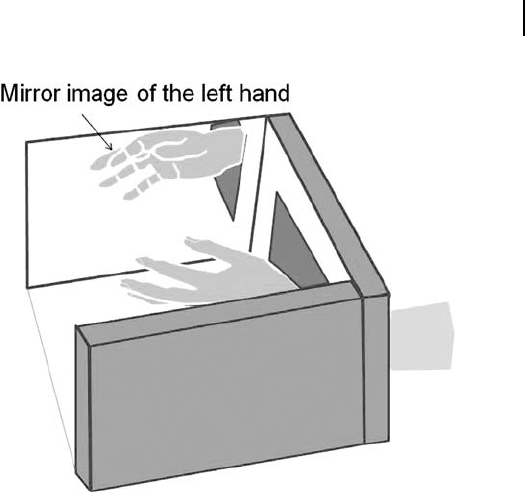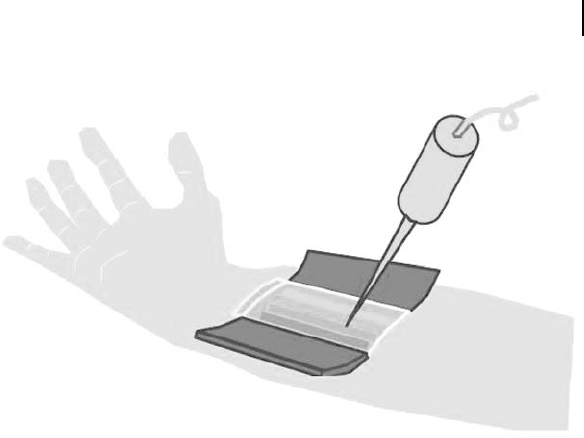June 25, 2012 14:20 PSP Book - 9in x 6in 10-Junichi-Takeno-c10
218 Physical Demonstration of Successful Mirror Image Cognition by a Robot
whether the partner is actually the self or the other robot based on
the coincidence rate of the behavior of being a part of the body of
the self. For these reasons, we conclude that a 100% cognition rate
has been achieved with regard to the condition that all robots used
in our experiments possess the same normalized and functional
specifications.
10.8 Investigations and Prospects
10.8.1 An Elucidation
Mirror image robot Rm is an existence closer to self robot Rs
than robot Rc, which is part of the self (from the results of our
experiments).
Humans become aware that mirror images are a part of the
self (self-body theory). In other words, the author has discovered
the physical meaning of humans being able to become aware that
the image of the self in a mirror is the self. According to these
experiments, the mirror image of the self is the other that is
separated from the self. It is a special “other” and generates a sense
of being part of the body of the robot. The LED lights up not because
the coincidence rate of the behaviors between the mirror image and
the self robot reaches 100%. The self robot recognizes that its image
in the mirror is an existence that is closer to it than any part of it
is. In other words, the robot’s recognition that the mirror image is
closer to the self than any part of self is has reached 100%.
We have now solved the mystery: The robot recognizes the image
ambiguously, and the mirror image is felt to be a part of the body of
the robot.
10.8.2 Mirror Box Therapy
The human brain can feel the existence of lost limbs. After a person
loses a hand or a leg in an accident, the person sometimes feels
that the lost limb still exists on the body. This is called the phantom
limb phenomenon. The phantom limb sometimes gives rise to
phantom pain. Dr. V. S. Ramachandran, a US neurologist, succeeded

June 25, 2012 14:20 PSP Book - 9in x 6in 10-Junichi-Takeno-c10
Investigations and Prospects 219
Figure 10.9. A scene of mirror box therapy.
in eliminating phantom pain from patients using his mirror box
therapy (Fig. 10.9). The author’s experiment-derived theory that the
mirror image of the self is felt like a part of the body of the self
provides physical support for the success of Ramachandran’s mirror
box therapy.
10.8.3 Mirror Stage
This observation is another physical demonstration of the mirror
stage hypothesis (self-body theory) introduced by the French
psychopathologist Jacques Lacan (1901–1981). According to the
author’s theory, the cognition of the self and the other is necessary
before being able to cognize the mirror image of the self based on
the results of the cognition of behaviors of the self and the other,
i.e., to succeed in mirror image recognition. The mirror stage seems
to refer to a stage where the behaviors of the self and the other are
cognized separately and where the relationship between the self and
the other (the meaning of the self and the other) can be cognized.

June 25, 2012 14:20 PSP Book - 9in x 6in 10-Junichi-Takeno-c10
220 Physical Demonstration of Successful Mirror Image Cognition by a Robot
(a) (b)
Figure 10.10. Jacques’s mirror stage (a) and she knows her body (b).
The mirror stage hypothesis assumes that infants establish the
self as they cognize their mirror image and become aware of their
integrated physical bodies in the early stage of development of their
neural systems, which is called the mirror stage (Fig. 10.10).
10.8.4 Can Self Robot Discriminate Itself from Any
Other Robots?
The answer is no. If the other robot possesses functions exceeding
the self robot’s capability (mobility and sensor capacity), the self
robot will determine that the other robot is part of the self. Actually,
an imaginable super robot cannot exceed the performance of its
image in the mirror. This observation provides the grounds for
believing that any artificial limbs that exceed the function of the self
are a real part of the self even though they are not the real living
limbs (Fig. 10.11). It can be judged, therefore, that artificial limbs are
the real parts of the self (artificial limb hypothesis). This hypothesis
is good news for those who must live with the discomfort of using
artificial limbs after loss of their own limbs, because it provides a
physical theory for artificial limbs to be accepted as if they were real
limbs by the brain.

June 25, 2012 14:20 PSP Book - 9in x 6in 10-Junichi-Takeno-c10
Investigations and Prospects 221
Figure 10.11. Artificial arm that feels like one’s own arm.
The result of mirror image cognition experiments using robots
supports Lacan’s mirror stage hypothesis that humans become
aware of the image of the self reflected in a mirror at infancy and
thereafter further develop their cognitive functions.
10.8.5 Mysteries of Illusions of Reality
The result of Experiment 1 suggests that the coincidence rate of the
robot behavior cannot theoretically reach 100% because of various
disturbances existing in the environment. This gives rise to the
hypothesis that human cognition is always ambiguous (ambiguous
recognition hypothesis). As can be demonstrated by experiments,
two-point discrimination regarding the skin sensation of humans is
not always successful, but its success depends on the location (van
Nes et al., 2008).
When you look at people walking along the street and try to tell
their gender, you cannot always be correct. Doctors cannot always
correctly diagnose lesions hidden in the body.
The above hypothesis might have been proved true, but the
following mystery still haunts: However ambiguous sensations may
June 25, 2012 14:20 PSP Book - 9in x 6in 10-Junichi-Takeno-c10
222 Physical Demonstration of Successful Mirror Image Cognition by a Robot
be, humans understand them as if they represented “sure existence.”
Examples include the phenomena of phantom limbs and phantom
pain. These phenomena are called illusions of reality.
The cognitive function of humans is made up of “living machines.”
Since machines are involved in the cognitive function of humans,
various disturbances in the external world (including physical
disturbances generating from the human body) affect the process
of cognition in the brain. And the result of cognition is always
ambiguous both theoretically and physically. Nevertheless, the brain
never fails to understand the existence of reality even though
ambiguous cognition is used. This mystery is called the illusion of
reality.
10.8.6 Study of Human Brain Using Mirror Image
Cognition Robot
The MoNAD modules proposed by the author can describe many
phenomena of human consciousness because the author’s definition
of consciousness is based on knowledge of the phenomena of
human consciousness. Scientific knowledge tells us that the human
brain consists of about 100 billion brain cells, with information
entering and leaving these cells, i.e., being transmitted to other
cells. In addition, some regular information is sent from certain
areas in the brain to other areas or circulates between them. For
example, information arrives from the body, passes through the
spinal cord, and reaches the parietal lobe via the central part
of the brain. Some other information is exchanged between the
parietal lobe and the frontal lobe, and between the frontal lobe
and the central part of the brain. Although there remains the
dream that unknown substances are related to the function of
human consciousness, it is necessary to try to identify the function
of human consciousness on the basis of only currently available
scientific knowledge. The author believes that human consciousness
is formed not just by information circulating in the brain and that
the information circulating between the brain and the body also
plays a critical role. The author supposes the existence of MoNADs
from these information circulations and judges that the MoNADs
..................Content has been hidden....................
You can't read the all page of ebook, please click here login for view all page.
